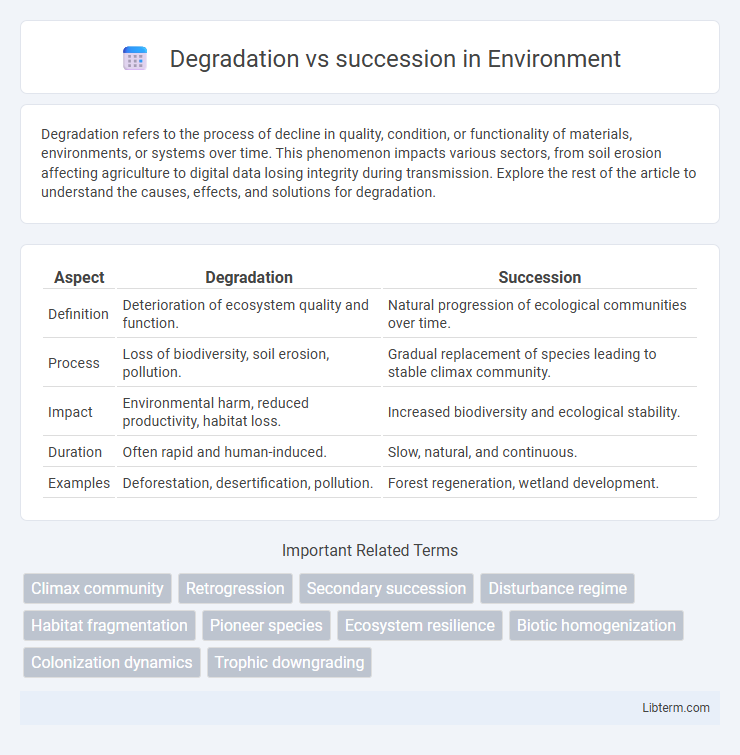Degradation refers to the process of decline in quality, condition, or functionality of materials, environments, or systems over time. This phenomenon impacts various sectors, from soil erosion affecting agriculture to digital data losing integrity during transmission. Explore the rest of the article to understand the causes, effects, and solutions for degradation.
Table of Comparison
| Aspect | Degradation | Succession |
|---|---|---|
| Definition | Deterioration of ecosystem quality and function. | Natural progression of ecological communities over time. |
| Process | Loss of biodiversity, soil erosion, pollution. | Gradual replacement of species leading to stable climax community. |
| Impact | Environmental harm, reduced productivity, habitat loss. | Increased biodiversity and ecological stability. |
| Duration | Often rapid and human-induced. | Slow, natural, and continuous. |
| Examples | Deforestation, desertification, pollution. | Forest regeneration, wetland development. |
Understanding Ecosystem Degradation
Ecosystem degradation involves the decline in ecosystem health due to factors like pollution, deforestation, or climate change, leading to loss of biodiversity and reduced ecosystem services. Succession is the natural process of ecosystem recovery where species composition and community structure gradually change over time, often progressing toward a stable climax community. Understanding ecosystem degradation highlights the importance of mitigating human impacts to support succession and restore ecological balance.
Defining Ecological Succession
Ecological succession is the natural process by which ecosystems undergo gradual change and development over time, leading to increased biodiversity and structural complexity. It involves the sequential replacement of one biological community by another until a stable climax community is established. In contrast, degradation refers to the decline or deterioration of ecosystem health and function due to disturbances or human impacts.
Key Differences Between Degradation and Succession
Degradation refers to the decline in ecosystem quality due to factors like pollution, deforestation, or soil erosion, resulting in loss of biodiversity and ecosystem services. Succession describes the natural, progressive replacement of species in an ecosystem over time, leading to increased stability and biodiversity. Key differences include degradation causing negative impacts and reduction in ecosystem function, whereas succession drives positive ecological development and habitat complexity.
Causes of Ecosystem Degradation
Ecosystem degradation primarily results from factors such as deforestation, pollution, climate change, and unsustainable agricultural practices that disrupt natural nutrient cycles and reduce biodiversity. Habitat fragmentation and invasive species introduction further accelerate the loss of ecosystem resilience, impairing ecological functions. These causes collectively undermine ecosystem services, leading to diminished soil fertility, water quality, and carbon sequestration capacity.
Stages and Types of Ecological Succession
Ecological succession involves distinct stages: pioneer, intermediate, and climax, marking gradual ecosystem development from simple to complex communities. Two primary types are primary succession, occurring on lifeless substrates with no soil, and secondary succession, following disturbance in previously inhabited areas where soil remains. In contrast, degradation signifies ecosystem decline due to factors like pollution or deforestation, reversing succession processes and reducing biodiversity and ecosystem function.
Human Impact on Degradation and Succession
Human activities accelerate ecosystem degradation by increasing soil erosion, pollution, and habitat destruction, disrupting natural nutrient cycles and lowering biodiversity. Land-use changes such as deforestation, urbanization, and agriculture alter successional trajectories, often preventing ecosystems from progressing to mature stages. Restoration efforts focus on mitigating human impact to enable natural succession processes and rehabilitate degraded environments.
Indicators of Degraded Ecosystems
Indicators of degraded ecosystems include reduced biodiversity, soil erosion, and declining water quality, reflecting ecosystem imbalance and stress. Persistent presence of invasive species and loss of native vegetation signal successional disruption, hindering natural recovery processes. Changes in nutrient cycling, such as decreased soil fertility and altered microbial activity, further exemplify degradation impacting ecosystem health and functionality.
Restoration Ecology: Reversing Degradation
Restoration ecology focuses on reversing ecosystem degradation by promoting natural succession processes, enabling degraded habitats to recover and regain biodiversity. Degradation involves the loss of ecosystem structure and function due to disturbances, while succession refers to the natural progression of ecological communities toward a stable state. Strategies in restoration ecology aim to accelerate succession, improve soil health, and reestablish native species to restore ecosystem services.
Succession as a Tool for Ecosystem Recovery
Succession serves as a natural process facilitating ecosystem recovery by enabling gradual biological changes that restore biodiversity and ecological functions. Primary and secondary succession promote soil formation, species diversification, and habitat complexity, counteracting degradation effects caused by disturbances like deforestation or wildfires. Utilizing succession as a restoration tool enhances ecosystem resilience, supports carbon sequestration, and fosters sustainable habitat regeneration.
Future Challenges in Managing Degradation and Succession
Future challenges in managing degradation and succession involve balancing ecosystem restoration with land-use demands, as accelerating climate change intensifies soil erosion and biodiversity loss. Implementing adaptive management strategies that incorporate predictive modeling and community engagement is critical for mitigating irreversible ecological damage. Addressing these challenges requires integrating scientific research on successional trajectories with policy frameworks to enhance resilience and sustainable resource use.
Degradation Infographic

 libterm.com
libterm.com